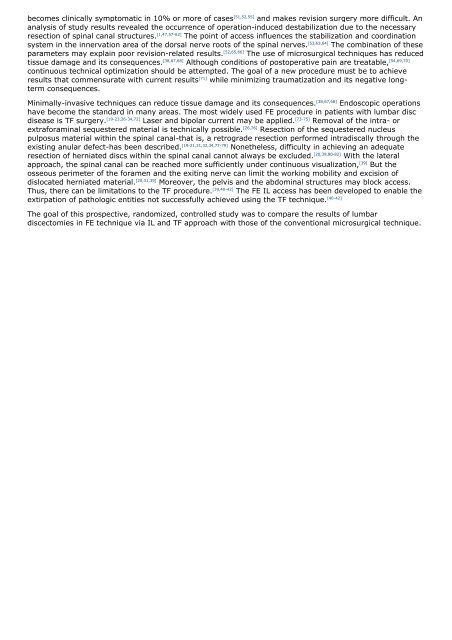Full-Endoscopic Interlaminar and Transforaminal ... - Max-more
Full-Endoscopic Interlaminar and Transforaminal ... - Max-more
Full-Endoscopic Interlaminar and Transforaminal ... - Max-more
You also want an ePaper? Increase the reach of your titles
YUMPU automatically turns print PDFs into web optimized ePapers that Google loves.
ecomes clinically symptomatic in 10% or <strong>more</strong> of cases [51,52,55] <strong>and</strong> makes revision surgery <strong>more</strong> difficult. An<br />
analysis of study results revealed the occurrence of operation-induced destabilization due to the necessary<br />
resection of spinal canal structures. [1,47,57-62] The point of access influences the stabilization <strong>and</strong> coordination<br />
system in the innervation area of the dorsal nerve roots of the spinal nerves. [53,63,64] The combination of these<br />
parameters may explain poor revision-related results. [52,65,66] The use of microsurgical techniques has reduced<br />
tissue damage <strong>and</strong> its consequences. [38,67,68] Although conditions of postoperative pain are treatable, [54,69,70]<br />
continuous technical optimization should be attempted. The goal of a new procedure must be to achieve<br />
results that commensurate with current results [71] while minimizing traumatization <strong>and</strong> its negative longterm<br />
consequences.<br />
Minimally-invasive techniques can reduce tissue damage <strong>and</strong> its consequences. [38,67,68] <strong>Endoscopic</strong> operations<br />
have become the st<strong>and</strong>ard in many areas. The most widely used FE procedure in patients with lumbar disc<br />
disease is TF surgery. [19-23,26-34,72] Laser <strong>and</strong> bipolar current may be applied. [73-75] Removal of the intra- or<br />
extraforaminal sequestered material is technically possible. [26,76] Resection of the sequestered nucleus<br />
pulposus material within the spinal canal-that is, a retrograde resection performed intradiscally through the<br />
existing anular defect-has been described. [19-21,31,32,34,77-79] Nonetheless, difficulty in achieving an adequate<br />
resection of herniated discs within the spinal canal cannot always be excluded. [20,39,80-82] With the lateral<br />
approach, the spinal canal can be reached <strong>more</strong> sufficiently under continuous visualization, [39] But the<br />
osseous perimeter of the foramen <strong>and</strong> the exiting nerve can limit the working mobility <strong>and</strong> excision of<br />
dislocated herniated material. [20,31,39] Moreover, the pelvis <strong>and</strong> the abdominal structures may block access.<br />
Thus, there can be limitations to the TF procedure. [39,40-42] The FE IL access has been developed to enable the<br />
extirpation of pathologic entities not successfully achieved using the TF technique. [40-42]<br />
The goal of this prospective, r<strong>and</strong>omized, controlled study was to compare the results of lumbar<br />
discectomies in FE technique via IL <strong>and</strong> TF approach with those of the conventional microsurgical technique.




